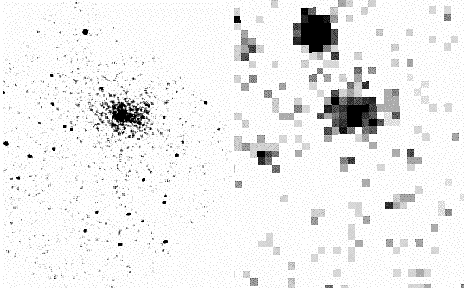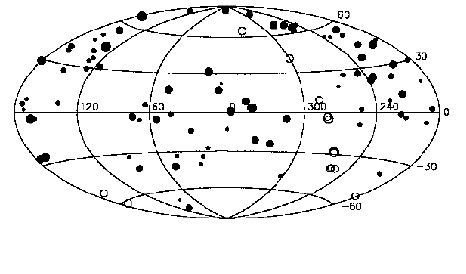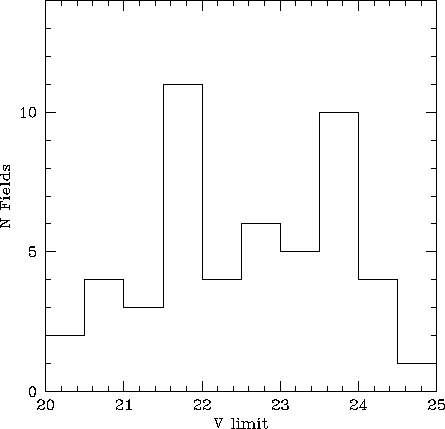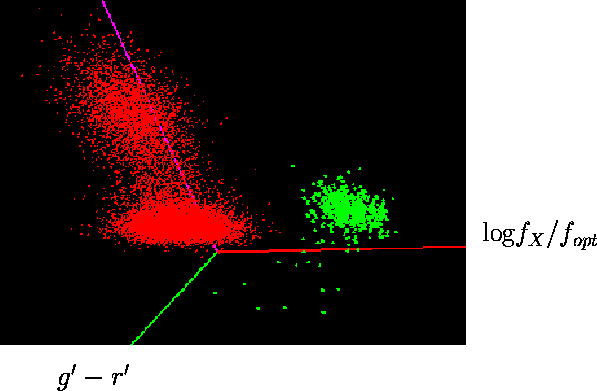The large fields-of-view (FoVs) typical of X-ray imaging instruments
have long been exploited for serendipitous surveys, resulting in
far-reaching and fundamental advances in our knowledge of the X-ray
universe and indeed the universe as a whole. The unprecedented spatial
resolution of Chandra (
![]() 0.5
0.5
![]() at field center) combined with
its very low background, allows a view of the X-ray sky up to 20 times
deeper than previous X-ray surveys as well as highly efficient source
identification based on the accurate X-ray positions1. A multi-institution
collaboration (including: CXC, MIT, CfA, MMTO, KPNO, CTIO, UofA, SFSU,
MSU, SDSS, OSU) is carrying out a serendipitous survey, the Chandra
Multi-wavelength Project (ChaMP), using Chandra archival, full FoV
imaging data with a wide range of exposure times. We estimate that the
ChaMP X-ray sample will total
at field center) combined with
its very low background, allows a view of the X-ray sky up to 20 times
deeper than previous X-ray surveys as well as highly efficient source
identification based on the accurate X-ray positions1. A multi-institution
collaboration (including: CXC, MIT, CfA, MMTO, KPNO, CTIO, UofA, SFSU,
MSU, SDSS, OSU) is carrying out a serendipitous survey, the Chandra
Multi-wavelength Project (ChaMP), using Chandra archival, full FoV
imaging data with a wide range of exposure times. We estimate that the
ChaMP X-ray sample will total
![]() sources in
sources in ![]() sq. degs. per year and run for 5 years, thus including statistically
robust samples of rare source types such as BL Lac objects, quiescent
X-ray binaries, and high-redshift clusters.
sq. degs. per year and run for 5 years, thus including statistically
robust samples of rare source types such as BL Lac objects, quiescent
X-ray binaries, and high-redshift clusters.
The aim of the ChaMP survey is to make use of the parts of the images which are not the primary science of the PI project. For instance, we omit fields which have a large galaxy in them or an X-ray bright cluster of galaxies. We are concentrating on fields which have, for example, a point source as the main science objective. In this way, we will assemble our sky sample from data not expected to be intensively studied by the PI's. 14% of the Chandra AO1 fields met the criteria for inclusion in ChaMP. The analysis the team will do on such topics as testing the source detection algorithms, understanding the background, and the relation between the two on a large sky area will be a result from Champ which will benefit the whole Chandra community.
To unambiguously classify the X-ray sources into the various source types - stars, galaxies, clusters, and active galactic nuclei (AGN) - optical fluxes are required. We have designed an optical imaging program to reach optical magnitude limits (20-25) matched to the X-ray flux limit for each field. The combination of three-color optical and X-ray fluxes will allow classification of > 75% of the X-ray sources both within and outside the Galactic Plane. Optical spectroscopy to determine redshifts and verify classification methods will be obtained for a significant, representative subset.
The optically identified ChaMP X-ray selected sample will enable us to address several key questions already posed by a variety of research areas in astronomy while no doubt providing the surprises that usually result from new levels of sensitivity and resolution. The scientific motivation includes:
![]() Complement the small-area, deep Chandra surveys, which will resolve
the majority of the soft (0.5-2.5 keV) and hard (2-10 keV) Cosmic
X-ray background (CXRB), by covering a larger area to brighter flux
limits, providing strong constraints on the
Complement the small-area, deep Chandra surveys, which will resolve
the majority of the soft (0.5-2.5 keV) and hard (2-10 keV) Cosmic
X-ray background (CXRB), by covering a larger area to brighter flux
limits, providing strong constraints on the
![]() intermediate
between pre-Chandra and Chandra deep surveys.
intermediate
between pre-Chandra and Chandra deep surveys.
![]() Determine the X-ray luminosity function (LF) of AGN and other
source types as a function of redshift to fainter flux levels than
previously.
Determine the X-ray luminosity function (LF) of AGN and other
source types as a function of redshift to fainter flux levels than
previously.
![]() Provide a uniform sample of AGN relatively unaffected by the
biases due to line-of-sight absorption that are present in existing
optical and soft-X-ray surveys. Study AGN Spectral Energy
Distributions (SEDs) as a function of redshift, luminosity and AGN
type to probe their primary and secondary energy sources.
Provide a uniform sample of AGN relatively unaffected by the
biases due to line-of-sight absorption that are present in existing
optical and soft-X-ray surveys. Study AGN Spectral Energy
Distributions (SEDs) as a function of redshift, luminosity and AGN
type to probe their primary and secondary energy sources.
![]() Identify high redshift (z
Identify high redshift (z![]() )
clusters of galaxies to
constrain cosmological parameters and to determine cluster evolution by
comparison with lower redshift samples.
)
clusters of galaxies to
constrain cosmological parameters and to determine cluster evolution by
comparison with lower redshift samples.
![]() Double the number of known galactic plane cataclysmic variables
(CVs), with the most luminous seen at > 10 times the current
distance limit. Measure the X-ray luminosity function of accreting
binary stars such as CVs and low mass X-ray binaries, (LMXBs).
Double the number of known galactic plane cataclysmic variables
(CVs), with the most luminous seen at > 10 times the current
distance limit. Measure the X-ray luminosity function of accreting
binary stars such as CVs and low mass X-ray binaries, (LMXBs).
![]() Study the coronal X-ray emission of main sequence stars from the
onset of dynamo activity in A stars to late-M stars, where the cores
are fully convective.
Study the coronal X-ray emission of main sequence stars from the
onset of dynamo activity in A stars to late-M stars, where the cores
are fully convective.
 |
The advantages of Chandra are graphically demonstrated in Fig. 13,
which shows a Chandra ACIS-S image of the z![]() cluster
RXJ003033.2+261819, taken during Orbital Activation and Calibration,
as compared with the ROSAT PSPC image of the same area of sky. The
cluster, while barely resolved with ROSAT, is clearly an extended
source in the Chandra image and the order of magnitude improvement in
the X-ray positions is also clear.
cluster
RXJ003033.2+261819, taken during Orbital Activation and Calibration,
as compared with the ROSAT PSPC image of the same area of sky. The
cluster, while barely resolved with ROSAT, is clearly an extended
source in the Chandra image and the order of magnitude improvement in
the X-ray positions is also clear.
The analysis of serendipitous sources in this field,
shows 24 detected point sources outside the immediate cluster region
(Cappi et al. 2000).
A typical source has 20 counts, or
![]() erg cm-2 s-1,
ROSAT detected 11 sources to
10-14erg cm-2 s-1. In an
erg cm-2 s-1,
ROSAT detected 11 sources to
10-14erg cm-2 s-1. In an
![]() area surrounding
the cluster, the 0.5-2 keV surface density of point sources
(
area surrounding
the cluster, the 0.5-2 keV surface density of point sources
(
![]() above
above
![]() erg cm-2 s-1) exceeds by a factor
erg cm-2 s-1) exceeds by a factor ![]() that
expected based on the ROSAT
that
expected based on the ROSAT
![]() .
This high density is seen despite
the relatively high Galactic absorbing column for the field
(
.
This high density is seen despite
the relatively high Galactic absorbing column for the field
(
![]() ).
A non-cluster comparison
field shows no such excess. Optical identifications and
redshifts are needed to confirm the implied association with the cluster.
).
A non-cluster comparison
field shows no such excess. Optical identifications and
redshifts are needed to confirm the implied association with the cluster.
 |
 |
The wide availability of optical catalogs and surveys at the bright
end of this range allows us to design an efficient identification
program using existing material where possible. At fainter optical
magnitudes no catalogs are currently available3.
The limiting optical V magnitudes required for the ChaMP Cycle 1
list of 74 fields are in the range 20.5
![]() V
V
![]() 24.7 (Fig 15).
Optical imaging will require
24.7 (Fig 15).
Optical imaging will require ![]() nights per year
on a combination of 4 m and 0.9 m telescopes at NOAO (KPNO and CTIO)
and 1.5m at SAO (Smithsonian Astrophysical Observatory) using
the large area (4 shooter or MOSAIC) detectors.
28 nights were awarded by NOAO and SAO
between Dec 1999 and Jun 2000 with 17 completed to date.
We have submitted proposals to the NOAO Survey and SAO longterm programs
(for the fields with brighter flux limits)
to obtain the remainder of the nights assuming a similar area
will be covered each year.
nights per year
on a combination of 4 m and 0.9 m telescopes at NOAO (KPNO and CTIO)
and 1.5m at SAO (Smithsonian Astrophysical Observatory) using
the large area (4 shooter or MOSAIC) detectors.
28 nights were awarded by NOAO and SAO
between Dec 1999 and Jun 2000 with 17 completed to date.
We have submitted proposals to the NOAO Survey and SAO longterm programs
(for the fields with brighter flux limits)
to obtain the remainder of the nights assuming a similar area
will be covered each year.
Optical and X-ray source properties will be combined in order to
classify the sources. At high galactic latitude, SDSS
![]() and
and
![]() filters provide the best option for efficient
source classification. Fig. 16 illustrates how 3 SDSS filters and
X-ray fluxes yield a multicolor space of unprecedented AGN selection
efficiency across all redshifts. All AGN are separated from stars
following the the color-plane methodology of Newberg et al. (1998).
Often, further discrimination will be available from optical
and X-ray morphology and from X-ray spectral information.
filters provide the best option for efficient
source classification. Fig. 16 illustrates how 3 SDSS filters and
X-ray fluxes yield a multicolor space of unprecedented AGN selection
efficiency across all redshifts. All AGN are separated from stars
following the the color-plane methodology of Newberg et al. (1998).
Often, further discrimination will be available from optical
and X-ray morphology and from X-ray spectral information.
(hea-www.harvard.edu/CHAMP/) along with the field lists for each Chandra Cycle as they become available. The ChaMP X-ray and optical data and X-ray catalog products will be made publicly available on a field-by-field basis within a year of completion of the data reduction of the full dataset for that field. We are confident that the multi-wavelength dataset so provided will prove a valuable scientific resource for the community.
- Belinda Wilkes, Paul Green
Cappi, M. et al., 2000, ApJ, submitted
Fan, X. 1999, AJ, 117,2528
Miyaji, T., Hasinger, G., Schmidt, M. 2000, AA, in press
Newberg, H., J., Richards, G.T., Fan, X. & Laurent-Muehleison 1998, BAAS, 30, 1412
Stocke, J. T. et al 1991, ApJS, 76, 813
1The degraded inflight energy resolution of part of the ACIS instrument does not affect the ChaMP survey limits.
2available on the CXC website asc.harvard.edu
3Once the Sloan Digital Sky Survey (SDSS) archive for all
northern fields opens (
![]() ), it will cover ChaMP imaging
needs to V<23 with the same filters as the remainder of the ChaMP.
While these magnitudes will not be temporally as close to Chandra
observations as our own imaging, they will reduce our need for
telescope time for northern fields, while still ensuring color
uniformity with the ChaMP.
), it will cover ChaMP imaging
needs to V<23 with the same filters as the remainder of the ChaMP.
While these magnitudes will not be temporally as close to Chandra
observations as our own imaging, they will reduce our need for
telescope time for northern fields, while still ensuring color
uniformity with the ChaMP.
 |